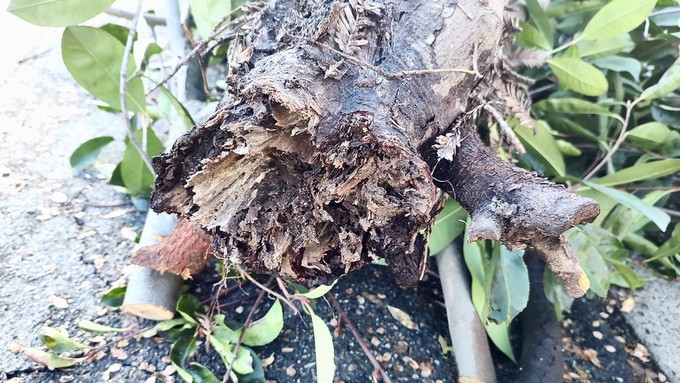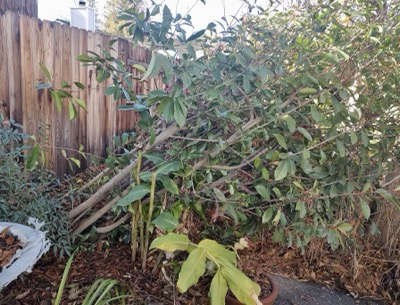
Hidden by too much ‘mulch,’ crown rot revealed by wind gust

With almost no roots left to hold it in place, this photinia fell over in Saturday's storm. Debbie Arrington
Why do trees (or large shrubs) suddenly fall during a big storm? The problem often lies at the roots.
Right after warning Sacramento Digs Gardening readers about trees that are leaning, I lost one of my 12-foot photinias. Blasted by wind, it fell over during Saturday’s storm.
This was a red-tip Fraser photinia – one of the most common hedge shrubs in Sacramento – and seemingly healthy. As an evergreen, it still had lots of foliage. And that canopy also was part of what led to its sudden downfall; the broad leaves apparently caught a sudden gust and that toppled the tree right over.
My first thought when I saw it: How do I get this big shrub up and stabilized? But this photinia was a goner.
On closer inspection, I discovered the photinia had snapped off at the base of its multi-trunks – it was a victim of crown rot. Only one healthy (albeit very thick) root had been holding the tree upright. There were signs of rot all around the crown (where the trunks meet the soil).
Unfortunately, it took the shrub falling over to reveal the rot. And I feel partly responsible.

Planted when our home was built in 1980, the photinia was under a gigantic coastal redwood that hangs over the fence and dumps loads of debris. That redwood litter had accumulated between the fence and the trunk of the photinia, mounding around the crown.
While the redwood litter mulched the shrub and helped it through drought, it also kept too much moisture around the crown, allowing fungal disease to take hold. (Yes, you can have too much mulch.)
Crown rot is caused by funguslike water molds, according to the UCANR pest notes. Above-ground signs of this infection include twig or branch dieback, undersized or discolored leaves and dropped foliage. Mature shrubs or trees infected by these molds grow slowly and gradually decline.
My photinia had shown some twig dieback, but I attributed this to the drought. It also grew much slower in recent years; for a shrub that needs regular pruning, I thought that was a good thing.
But now there’s a wide hole in my photinia hedge. While I couldn’t save the fallen photinia, I’m raking out that redwood debris from under the remaining shrubs so their crowns can dry out.
For more on crown rot: http://ipm.ucanr.edu/PMG/GARDEN/FRUIT/DISEASE/pchphytoph.html.
Comments
0 comments have been posted.Sacramento Digs Gardening to your inbox.
Food in My Back Yard Series
May 6: Maintain soil moisture with mulch for garden success
April 29: What's (already) wrong with my tomato plants?
April 22: Should you stock up on fertilizer? (Yes!)
April 15: Grow culinary herbs in containers
April 8: When to plant summer vegetables
April 1: Don't be fooled by these garden myths
March 25: Fertilizer tips: How to 'feed' your vegetables for healthy growth
March 18: Time to give vegetable seedlings some more space
March 11: Ways to win the fight against weeds
March 4: Potatoes from the garden
Feb. 25: Plant a fruit tree now -- for later
Feb. 18: How to squeeze more food into less space
Feb. 11: When to plant? Consider staggering your transplants
Feb. 4: Starting in seed starting
Sites We Like
Garden Checklist for week of May 4
Enjoy this spring weather – and get gardening!
* Plant, plant, plant! It’s prime planting season in the Sacramento area. Time to set out those tomato transplants along with peppers and eggplants. Pinch off any flowers on new transplants to make them concentrate on establishing roots instead of setting premature fruit.
* Direct-seed melons, cucumbers, summer squash, corn, radishes, pumpkins and annual herbs such as basil.
* Harvest cabbage, lettuce, peas and green onions.
* In the flower garden, direct-seed sunflowers, cosmos, salvia, zinnias, marigolds, celosia and asters. (You also can transplant seedlings for many of the same flowers.)
* Plant dahlia tubers. Other perennials to set out include verbena, coreopsis, coneflower and astilbe.
* Transplant petunias, marigolds and perennial flowers such as astilbe, columbine, coneflowers, coreopsis, dahlias, rudbeckia and verbena.
* Keep an eye out for slugs, snails, earwigs and aphids that want to dine on tender new growth.
* Feed summer bloomers with a balanced fertilizer.
* For continued bloom, cut off spent flowers on roses as well as other flowering plants.
* Add mulch to the garden to maintain moisture. Mulch also cuts down on weeds. But don’t let it mound around the stems or trunks of trees or shrubs. Leave about a 6-inch to 1-foot circle to avoid crown rot or other problems.